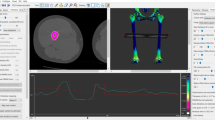Abstract
Summary
The present study is intended to investigate the degree to which insufficient internal rotation could impact the densitometric results and change the diagnosis. A significant difference was found between the results in nonstandard compared with standard rotation and an increase in the BMD and T- and Z-scores from nonstandard to standard rotation. Likewise, a change in diagnosis was observed in a significant proportion of patients.
Purpose
To investigate the impact of nonstandard rotation of hip on the densitometric results of femoral neck and total femur region as well as the amount of change in diagnosis (i.e., misclassification of diagnosis) based on hip region.
Methods
Ninety-seven patients (88 females and 9 males) were included in the study. After receiving informed consent, each subject underwent a densitometric scanning in two modes, one with standard rotation of the leg and the other with nonstandard rotation (i.e., the leg in relaxed position without applying the positioner to strap the foot to) of the same leg. All data were analyzed using the auto-analysis option of the HOLOGIC® software. Bone densitometric results, T- and Z-scores, rate of change in diagnosis, and also the agreement between the diagnoses in the two modes are calculated and compared by using a paired-sample t test and cross-tabulation.
Results
The mean age of 97 patients was 56.91 ± 11.70 years. A significant difference was found in the BMDs, T-scores, and Z-scores of the neck and total femur regions of interest in standard and nonstandard rotations. We found an increase in the BMD of the femoral neck and total femur of 0.020 and 0.010 g/cm2, respectively, from standard to nonstandard leg rotation and that this, in turn, led to a 0.4 and a 0.13 increases in T-scores of the neck and total femur, respectively, from standard to nonstandard rotation. In the diagnosis based on femoral neck only, the diagnosis changed in 17 (17.5%) patients, i.e., 12 (12.4%) from osteopenia to normal, 3 (3.1%) from osteoporosis to osteopenia, and 2 (2.0%) from below the expected range for age to within the expected range for age. There was only a change of one level in diagnosis.
Discussion and conclusions
According to the results, the changes in the BMD and T- and Z-scores can be interpreted as underdiagnosis or, in simple terms, not finding the disease or underestimating the level of disease. Therefore, proper rotation of the leg is an important factor during densitometry. Any deviation from standard rotation changes the BMD of those regions, and thereby the T- and Z-scores accordingly, and thus the diagnosis.

Similar content being viewed by others
References
Black DM, Rosen CJ (2016) Clinical practice. postmenopausal osteoporosis. N Engl J Med 374:254–262
Jackson RD, Donepudi S, Mysiw WJ (2008) Epidemiology of fracture risk in the Women’s Health Initiative. Curr Osteoporos Rep 6:155–161
Wu CH, Kao IJ, Hung WC, Lin SC, Liu HC, Hsieh MH, Bagga S, Achra M, Cheng TT, Yang RS (2018) Economic impact and cost-effectiveness of fracture liaison services: a systematic review of the literature. Osteoporos Int 29:1227–1242
International Atomic Energy Agency (2011) Dual energy X ray absorptiometry for bone mineral density and body composition assessment. International Atomic Energy Agency, Vienna
Blake GM, Fogelman I (2010) An update on dual-energy x-ray absorptiometry. Semin Nucl Med 40:62–73
Watts NB (2004) Fundamentals and pitfalls of bone densitometry using dual-energy X-ray absorptiometry (DXA). Osteoporos Int 15:847–854
Cheng XG, Nicholson PH, Boonen S, Brys P, Lowet G, Nijs J, Dequeker J (1997) Effects of anteversion on femoral bone mineral density and geometry measured by dual energy X-ray absorptiometry: a cadaver study. Bone 21:113–117
Wilson CR, Fogelman I, Blake GM, Rodin A (1991) The effect of positioning on dual energy X-ray bone densitometry of the proximal femur. Bone Miner 13:69–76
Rosenthall L (2004) Range of change of measured BMD in the femoral neck and total hip with rotation in women. J Bone Miner Metab 22:496–499
Goh JC, Low SL, Bose K (1995) Effect of femoral rotation on bone mineral density measurements with dual energy X-ray absorptiometry. Calcif Tissue Int 57:340–343
Lekamwasam S, Lenora RS (2003) Effect of leg rotation on hip bone mineral density measurements. J Clin Densitom 6:331–336
McKiernan F, Washington W (2005) Effect of subtle positioning flaws on measured bone mineral density of the hip. J Clin Densitom 8:330–334
Celik O, Salci Y, Manisali M, Korkusuz F (2009) The effect of hip rotation on bone mineral density of the proximal femur measured by dual energy X-ray absorptiometry. Eklem Hastalik Cerrahisi 20:71–77
Author information
Authors and Affiliations
Corresponding author
Ethics declarations
Conflicts of interest
None.
Ethical approval
The study was approved by the Ethics committee of the School of Medicine, Shahid Beheshti University of Medical Sciences.
Additional information
Publisher’s note
Springer Nature remains neutral with regard to jurisdictional claims in published maps and institutional affiliations.
Rights and permissions
About this article
Cite this article
Qutbi, M., Salek, A., Soltanshahi, M. et al. The impact of nonstandard hip rotation on densitometric results of hip regions and potential misclassification of diagnosis. Arch Osteoporos 14, 86 (2019). https://doi.org/10.1007/s11657-019-0635-9
Received:
Accepted:
Published:
DOI: https://doi.org/10.1007/s11657-019-0635-9




